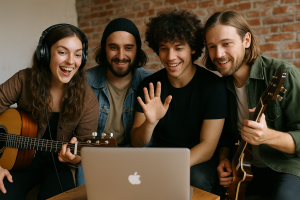5 Tips for Getting Your Band Listed in Music Directories That Fans Visit
 If you’re in a band and trying to grow your audience, music directories can be a great tool—if you’re showing up in the right ones. The truth is, most musicians don’t derive much value from directories because they either choose the wrong ones or submit their information in a way that doesn’t get noticed. A good example is 링크모음, which shows how being listed in the right place can make all the difference in visibility.
If you’re in a band and trying to grow your audience, music directories can be a great tool—if you’re showing up in the right ones. The truth is, most musicians don’t derive much value from directories because they either choose the wrong ones or submit their information in a way that doesn’t get noticed. A good example is 링크모음, which shows how being listed in the right place can make all the difference in visibility.
Here are five tips to help you get listed in music directories that people use—and make sure your listing gets results.
1. Focus on Directories Your Fans Use
Not all music directories are worth your time. Some are cluttered, outdated, or barely get any traffic. Others cater to genres or audiences that don’t match your style.
Start by doing some simple research. Google your genre with phrases like “best indie rock bands,” “top underground hip hop artists,” or “new metal bands to watch.” See which directories come up on the first page. Those are the ones people are visiting.
Also, look at where similar bands in your scene are listed. Are they getting featured on niche blogs, Spotify playlist directories, or regional music hubs? Pay attention to where fans are engaging—not just where artists are posting.
Tip: Prioritize directories that rank well in search, get shared on social media, or are linked in music discovery apps. Quality beats quantity.
2. Follow Submission Guidelines to the Letter
Every directory has its submission process. Some have a form. Others want an email. Some are curated and invite-only. The quickest way to get ignored is to skip the instructions or send a generic pitch.
Before you submit, read the guidelines carefully. Then, ensure that everything you send is complete, clear, and professional.
At a minimum, you’ll usually need:
- A short, compelling bio (2–3 sentences)
- A high-res band photo
- Links to your music (Spotify, Bandcamp, SoundCloud, etc.)
- Social media handles
- A recent release or standout track
Make it easy for the editor or curator to say yes. Don’t make them chase down missing info or guess what you’re about.
3. Tailor Your Pitch for Each Directory
Avoid the trap of copying and pasting the same message to every directory. Editors can spot a mass email instantly—and they rarely bother with them.
Instead, personalize your message. Mention why you think your band is a good fit for that directory. Reference a similar artist they’ve featured or a genre they focus on. Even one sentence of personalization shows you’ve done your homework.
You don’t have to write a novel. A concise and specific message is more effective than a lengthy and general one.
Example:
“Hey [Name], I saw you featured [Band X] on your site—we’ve played a few shows together and have a similar sound. Our new single just dropped, and I think it’d be a great fit for your [genre] section.”
That kind of message gets noticed.
4. Keep Your Links and Profiles Up to Date
There’s no point in getting listed if the information fans find is outdated. Before you submit to any directory, check that your:
- Spotify and Bandcamp pages are current
- Social media profiles have your latest release pinned
- Website (if you have one) is working and clean
- Press photos aren’t 5 years old
Also, ensure that your streaming links direct users to the correct tracks—not broken pages or private links.
Directories want to link to active, relevant artists. If your info looks abandoned, they’ll skip you, no matter how good the music is.
5. Promote the Listing After It’s Live
Once you get listed, don’t just move on—promote it. Share the link on social media, tag the directory, and thank them publicly. This helps in a few ways:
- It drives traffic to the directory (which they appreciate)
- It makes you look more legit to fans and other curators
- It encourages other directories to feature you
Also, keep the relationship going. Follow the directory on social, comment on their posts, and stay in touch. Next time you have a new release, you’ll already be on their radar.
Final Thought
Getting listed in music directories won’t blow up your band overnight. However, if you’re strategic and consistent, it can help new listeners discover you and establish trust with fans who are already seeking music like yours.
Don’t just aim for exposure—aim for the right exposure. Focus on the platforms that real fans visit, show up professionally, and treat every listing as a way to connect. The rest will follow.

 The interplay between celebrity culture and music trends is particularly evident in party settings, where hits often gain popularity based on celebrity endorsements or creations. This article explores how
The interplay between celebrity culture and music trends is particularly evident in party settings, where hits often gain popularity based on celebrity endorsements or creations. This article explores how  Social media is one of the musicians’ most powerful tools to grow their fan base. It allows them to connect with their fans and share their music with more people than ever. It can also connect with other musicians, fans, industry professionals, and potential collaborators.
Social media is one of the musicians’ most powerful tools to grow their fan base. It allows them to connect with their fans and share their music with more people than ever. It can also connect with other musicians, fans, industry professionals, and potential collaborators.